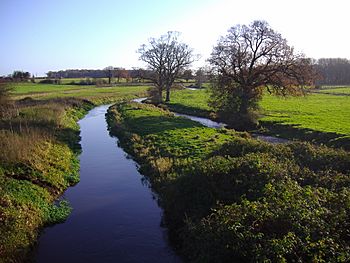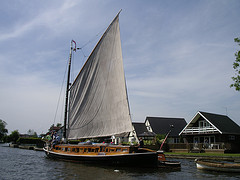River Bure facts for kids
Quick facts for kids River Bure |
|
|---|---|

River Bure at Aylsham
|
|
| Country | England |
| Physical characteristics | |
| Main source | Near Melton Constable |
| River mouth | Breydon Water, Great Yarmouth |
| Length | 50 miles (80 km) |
The River Bure is a river in Norfolk, England. Most of it flows through a special area called the Broads. It starts near Melton Constable. Long ago, boats could only go as far as Aylsham. Now, they can go a bit further, to Coltishall Bridge.
The River Bure flows through many towns and villages. These include Buxton Lammas, Coltishall, Wroxham, and Horning. It also passes by St. Benet's Abbey. The river continues through Acle and Great Yarmouth. Finally, it joins Breydon Water and flows into the sea at Gorleston.
The Bure has two main rivers that flow into it. These are the River Thurne and the River Ant. There is also Muck Fleet. This connects the Trinity Broads (Ormesby, Rollesby, and Filby Broad) to the main river system. Other smaller rivers also join the Bure. These include the River Hor, The Mermaid, and Scarrow Beck.
Contents
History of the River Bure
The River Bure has been used by boats for a long time. Since at least 1685, boats could travel about 31 miles (50 km) up to Horstead Mill. This mill is near Coltishall. These boats carried goods like coal, corn, and timber. They could get very close to Meyton Manor House. However, boats could not go past Coltishall. So, goods for Aylsham had to be moved by carts. These carts either took goods from boats at Coltishall or from boats at Cromer.
Making the River Easier to Use
In 1773, people wanted to make the river even better for boats. A special law was passed on April 7, 1773. This law allowed improvements to be made from Coltishall to Aylsham. The work was expected to cost about £6,000. Work started on June 29, 1774. The first lock and channel at Coltishall were finished by March 16, 1775. A lock is like a water elevator that helps boats move between different water levels.
However, the work was slow. By October 1777, much money had been spent. More money was needed to finish the project. Traders and landowners helped by lending money. The new waterway finally opened in October 1779.
Locks and Trade
Five locks were built along the river. These were at Aylsham, Burgh-near-Aylsham Mill, Oxnead Mill, Buxton Mill, and Coltishall. Soon after opening, the river started to get shallow because of mud. So, workers regularly had to clean the riverbed using a special scoop. This scoop was called a "didle."
Small boats called "wherries" were used. They could carry about 13 tons of goods. These goods included flour, farm products, coal, and timber. A brickyard at Oxnead also used the boats. Below Coltishall, a type of soil called marl was carried away. This marl came from pits connected by small boat channels. These channels are still there today in an area called Little Switzerland.
At each mill, new channels were dug for the locks. At Aylsham, a longer channel was made. It was about 1 mile (1.6 km) long and ended at a basin. Warehouses were built there. Boats could also reach Aylsham Mill Pool to deliver grain and pick up flour.
The river was quite successful for boats until 1880. That's when trains started to compete. The East Norfolk Railway built a line along the Bure valley. More train lines opened in 1883. Even with the trains, wherries used the river until 1912. Then, a big flood damaged the locks. It would have cost too much money to fix them. So, the river was no longer used for large boats. This was made official in 1928. Some of the old lock structures are still there, but the gates have been replaced with sluices, which control water flow.



